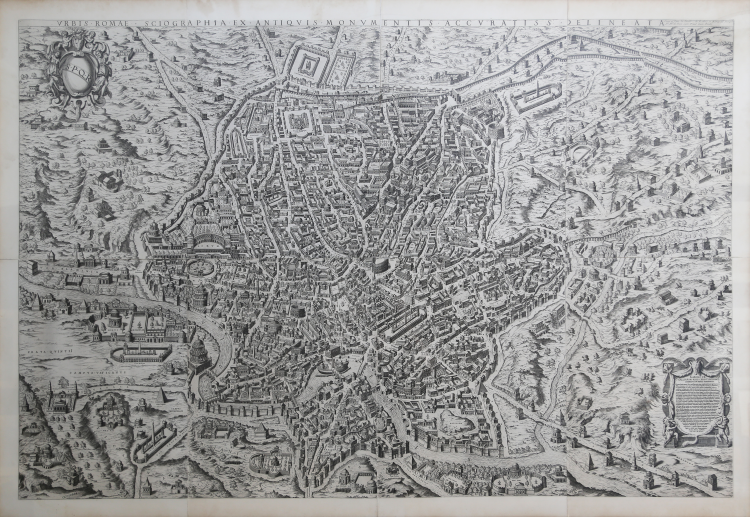




| Reference: | S51905 |
| Author | Etienne DUPERAC |
| Year: | 1574 ca. |
| Zone: | Rome |
| Printed: | Rome |
| Measures: | 1540 x 1030 mm |



| Reference: | S51905 |
| Author | Etienne DUPERAC |
| Year: | 1574 ca. |
| Zone: | Rome |
| Printed: | Rome |
| Measures: | 1540 x 1030 mm |
Vertical projection archaeological map, engraved by Etienne Duperac for the publisher Lorenzo Vaccari. Ideal reconstruction of Ancient Rome carried out by Duperac after a serious examination of the Severian map and the archaeological work by Pirro Ligorio, the greatest scholar of ancient monuments in Rome at the time. Inside the city, each building is outlined with the names of the main ones; these include the Colosseum, the Pantheon, the Baths of Diocletian and the Circus Maximus. Outside the city are marked the country estates (for example, the Gardens of Domitian), the funerary monuments (such as the Mausoleums of Hadrian and Augustus, and the circuses of Nero and Hadrian).
The plate was carved by the Parisian engraver and publisher Étienne Dupérac, who called himself Stephanus during his period of work in Rome (1569-1582). In the dedication to Charles IX, the author himself explains how this work is the result of fifteen years of study of all the ruins and monuments of Ancient Rome and related literary texts. In particular, a detailed account is given of the discovery of the Severian map, the remains of which were discovered in the church of Saints Cosma and Damiano in 1562.
Hülsen reports as the only known original example the one preserved at the British Museum, which bears the name of the printer Francesco Villamena. Furthermore, he adds that the catalogue of the Vaccari print shop includes the "Roma antica d’otto fogli reali, intagliata per mano di Stefano Duperach Parisino”, unknown to him. Frutaz rightly objects that the Villamena's edition is only a reprint, datable to the early 17th century, when the publisher was active in Rome.
In our research, we finally found an original example of the map, hitherto unknown, which is absolutely to be identified with the "Ancient Rome of eight royal sheets" of the Vaccari catalogue, quoted by Hülsen. In fact the exemplar, preserved in the cartographic collection of the Newberry Library of Chicago, bears the imprint of Lorenzo Vaccari, publisher also of the collection I Vestigi dell'Antichità di Roma Raccolti et Ritratti in Perspettiva con ogni diligentia by Stefano Dv Perac Parisino (1575).
Between 1649 and 1660, Gian Giacomo de Rossi published a reprint, using the same plates(presumably acquired from the Villamena workshop), but adding scenes from Ancient Rome and a typographical legend with 159 references to monuments. The work is described in the last catalogue of de Rossi's printing house, edited by Lorenzo Filippo in 1735 (p. 16, n. 1) as "Roma Antica di Stefano du Perac Parigino intagliata a bulino da Francesco Villamena co’ trionfi de Romani antichi, intagliati a bulino da Jacopo Lauro in dodici fogli reali grandi”. So the additional plates of the triumphs are, according to the catalogue, engraved by Giacomo Lauro. This attribution is rejected by Ashby and then by Hollstein, who attributes the plate to Peter de Jode. The de Rossi printing house was sold by Lorenzo Filippo, constituting the main fund of the newborn (1738) Calcografia Camerale (later Regia, then Nazionale and now Istituto Centrale per la Grafica), where the original plates are still preserved, mistakenly under the name of Francesco Villamena.
Etching and engraving in the fourth state of four described in Bifolco/Ronca, with imprint of the Calcografia Camerale in the cartouche and the stamp of the Calcografia Nazionale in the white margin (lower right corner). Beautiful proof, printed on paper dating to the last quarter of the 19th century, in perfect condition. The price and shipping do not include the frame.
Bibliografia
Bifolco-Ronca, Cartografia e topografia italiana del XVI secolo, pp. 2358-59, tav. 1214, IV/IV; Destombes (1970): n. 96; Caldana (2013): n. I.12; Frutaz (1962): n. XXII e tavv. 37-50; Grelle Iusco (1996): pp. 172, 379; Hollstein (1952): IX, p. 202, nn. 403-414; Hülsen (1915): XI, pp. 60-62, nn. 56-59; Mostra Bergamo (2016): n. 72; Scaccia Scarafoni (1939): nn. 18-19; Tooley (1983): n. 491a.
|
Etcher, engraver, painter and architect, from Bordeaux. Active in Venice and from 1559 in Rome.Returned to France either in 1578 or 1582. Died in Paris.
Duperac worked for various Roman print dealers, including Lafreri, Vaccari ,Faleti and P.P. Palumbo.He himself published some of his own work.Specialized in antiquities,maps and views.
Urbis Romae sciographia ex antiquis monumentis accuratiss. Delineata,1574.
Also the series,Vestigi dell’antichità di Roma ,1575.
|
|
Etcher, engraver, painter and architect, from Bordeaux. Active in Venice and from 1559 in Rome.Returned to France either in 1578 or 1582. Died in Paris.
Duperac worked for various Roman print dealers, including Lafreri, Vaccari ,Faleti and P.P. Palumbo.He himself published some of his own work.Specialized in antiquities,maps and views.
Urbis Romae sciographia ex antiquis monumentis accuratiss. Delineata,1574.
Also the series,Vestigi dell’antichità di Roma ,1575.
|